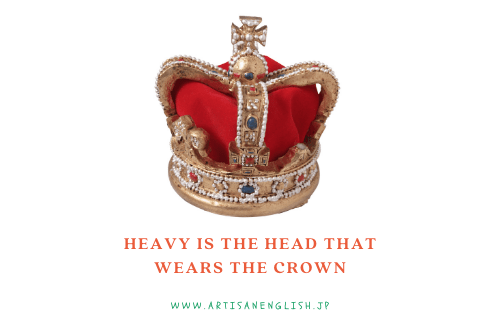
YouTube / iTunes / Spotify / Radio Public / Pocket Casts / Google Podcasts / Breaker / Overcast
Listen to ArtisanEnglish.jp posts & lesson intros here.
Proverb: Heavy is the head that wears the crown
We’re going to go back to Shakespeare for this one.
The modern version of the proverb is heavy is the head that wears the crown, but Shakespeare in Henry IV originally wrote it as ‘uneasy is the head that wears a crown.’
In a nutshell, the proverb means it is difficult for leaders to relax due to the significant burden of responsibility they carry.
Leading isn’t a walk in the park.
Heavy is the head that wears the crown means it is difficult for leaders to relax due to the significant burden of responsibility they carry.
Leaders are responsible for the success of their company and the people who work for them.
Ultimately when there are big decisions to be made, the buck stops with the one in charge.
They have to consider how the decisions they sign off on affect their companies and their employees.
If you know anything about Spiderman, you probably know the quote, “With great power comes great responsibility.”
Leaders have a lot of power and influence over others.
They have to be careful not to abuse that power or lose the respect of their employees.
Leading is not easy because it requires a lot of time and energy.
Many of us may dream of becoming the big kahuna one day, but how much do we realize that heavy is the head that wears the crown?
Here’s a little anecdote for you.
Did you know that Queen Elizabeth II insisted on wearing the St. Edward’s Crown during her coronation against the suggestion of others?
The St. Edwards Crown is quite heavy, and her handlers were concerned she would strain her neck or, worse, the crown would fall on the floor.
She insisted on wearing it because she wanted a physical reminder of her responsibility: heavy is the head that wears the crown.
Flesch-Kincaid Readability Test
This post is understandable by someone with at least an 8th-grade education (age 13 – 14).
On the Flesch-Kincaid reading-ease test, this post scores 67.
The easier a passage is to read, the higher the score on a scale of 0 – 100.

